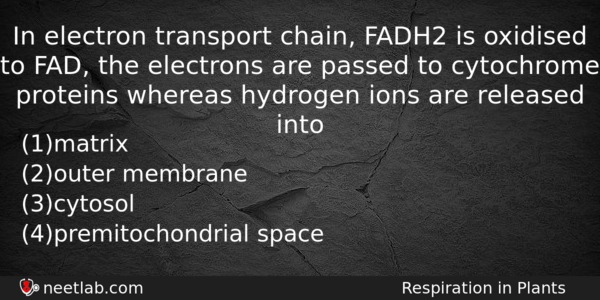| ⇦ | 
| ⇨ |
In electron transport chain, FADH2 is oxidised to FAD, the electrons are passed to cytochrome proteins whereas hydrogen ions are released into
Options
(a) matrix
(b) outer membrane
(c) cytosol
(d) premitochondrial space
Correct Answer:
cytosol
Explanation:
An electron transport chain or system is a series of coenzymes an cytochromes that take part in the passage of electron from a chemical to its ultimate acceptor. Energy released during passage of electrons from one carrier to the next is made available to specific transmembrane complexex, which pump protons (H⁺) from the matrix side of the inner mitochondrial membrane to the outer chamber or cytosol.Transport of the electrons from NADH over ETC helps in pushing three pairs of protons to the outer cytosol while two pairs of protons are sent outwardly during electron flow from FADH₂ (as the latter donates its electrons further down to the ETC).
Related Questions: - Autonomic nervous system is
- All living organisms are linked to one another because
- All cells contain
- In man the axial skeleton is made up of
- Compensation point is
Topics: Respiration in Plants
(184)
Subject: Biology
(4253)
Important MCQs Based on Medical Entrance Examinations To Improve Your NEET Score
- Autonomic nervous system is
- All living organisms are linked to one another because
- All cells contain
- In man the axial skeleton is made up of
- Compensation point is
Topics: Respiration in Plants (184)
Subject: Biology (4253)
Important MCQs Based on Medical Entrance Examinations To Improve Your NEET Score
18000+ students are using NEETLab to improve their score. What about you?
Solve Previous Year MCQs, Mock Tests, Topicwise Practice Tests, Identify Weak Topics, Formula Flash cards and much more is available in NEETLab Android App to improve your NEET score.
Share this page with your friends

Leave a Reply